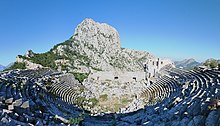
Back Termessos Azerbaijani Термесос Bulgarian Termessos Catalan Termessos German Τερμησσός Greek Termeso Esperanto Termeso Spanish ترمسوس Persian Termessos Finnish Termessos French
This article needs additional citations for verification. (May 2022) |
Τερμησσός (in Greek) | |
 Theatre in Termessos | |
| Location | Korkuteli, Antalya Province, Turkey |
|---|---|
| Region | Pisidia |
| Coordinates | 36°58′57″N 30°27′53″E / 36.98250°N 30.46472°E |
| Type | Settlement |
| Site notes | |
| Public access | Yes |
| Website | Termessos Archeological Site and National Park |
Termessos (Greek Τερμησσός Termēssós), also known as Termessos Major (Τερμησσός ἡ μείζων),[1] was a Pisidian city[2] built at an altitude of about 1000 metres at the south-west side of Solymos Mountain (modern Güllük Dağı) in the Taurus Mountains (modern Korkuteli, Antalya Province, Turkey). It lies 17 kilometres to the north-west of Antalya. It lies on a natural platform on the slopes of Güllük Dağı, which itself rises to 1,665 metres.
Termessos is one of the best preserved of the ancient cities in Turkey. The city was founded by the Solymi, who were mentioned by Homer in the Iliad in connection with the legend of Bellerophon.[3] Originally a Pisidian settlement, it integrated into the Greek world after Alexander the Great's conquests. By the turn of the second and third centuries CE, under Imperial Roman rule, it had become a thriving provincial city.[2]
Termessos is unique due to its exceptionally rich collection of inscriptions, providing valuable insights into its history and culture. The city has never been formally excavated but has been explored and surveyed, leading to extensive publications of over a thousand inscriptions.[2] Because of its natural and historical riches, the city is included in the Mount Güllük-Termessos National Park.[4]
- ^ Stephanus of Byzantium, Ethnica,Termessos
- ^ a b c van Nijf, Onno (2021). "Being Termessian: local knowledge and identity politics in a Pisidian city". Local Knowledge and Microidentities in the Imperial Greek World. Cambridge University Press. p. 163. ISBN 9781108984973.
- ^ https://whc.unesco.org/en/tentativelists/1412/ Retrieved-May-4-13
- ^ http://muze.gov.tr/termessos-en Archived 2016-12-01 at the Wayback Machine Retrieved April-30-2013
